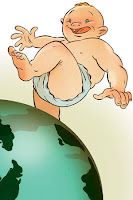Childhood Obesity Walks on Big Feet
Thursday, July 24, 2008 Feet are remarkably complex structures exquisitely designed to buffer and carry the weight of our bodies. Whether standing, running, jumping, hopping, skipping – the feet do it all. Not surprisingly, painful feet affect the whole organism.
Feet are remarkably complex structures exquisitely designed to buffer and carry the weight of our bodies. Whether standing, running, jumping, hopping, skipping – the feet do it all. Not surprisingly, painful feet affect the whole organism.
Interestingly, not much is known about the impact of increased body weight on foot architecture in kids. This knowledge is of course of great importance for orthopaedic and paediatric physicians with regard to prevention, clinical treatment and management of foot problems but also of obesity.
Now, Marlene Mauch and colleagues from the University of Tuebingen, Germany, studied the foot morphology of normal, underweight and overweight children in 1450 boys and 1437 girls aged 2-14 years (Int J Obesity). Foot morphology was measured using a three-dimensional (3D) foot scanner (Pedus, Human Solutions Inc., Germany) in a bipedal upright position. Twelve relevant 3D foot measures were recorded, as well as the children’s age, gender, height and mass.
Five foot types were identified: flat, robust, slender, short and long feet. While normal weight children displayed an almost equal distribution of all foot types throughout childhood, overweight and obese children were more likely to have flat and robust feet, whereas underweight children tended to have slender and long feet.
The authors not only conclude that excess weight may have a significant effect on foot morphology but may also increase the risk for foot discomfort as a result of various musculoskeletal disorders. This in turn may keep the overweight children from being active thereby further promoting weight gain.
Clearly, the role of foot morphology and the maintenance of foot health in overweight and obese kids deserves more attention and further study.
I would add that careful analysis of foot morphology and recommendation of proper footwear, orthotics and exercises should be part of every assessment of an overweight kid – damage to feet resulting from well-meant but ill-advised physical activity at an early age could precipitate lifelong foot problems and prove a major obstacle to long-term weight management.
AMS
Edmonton, Alberta


